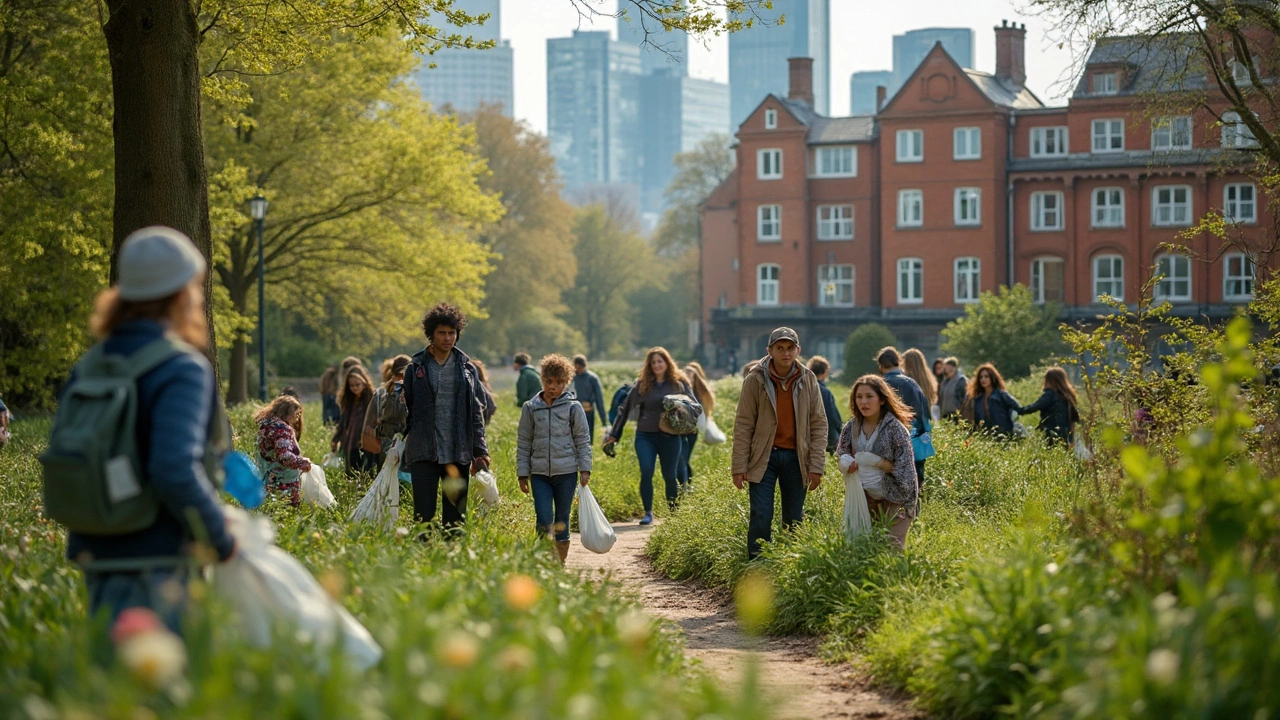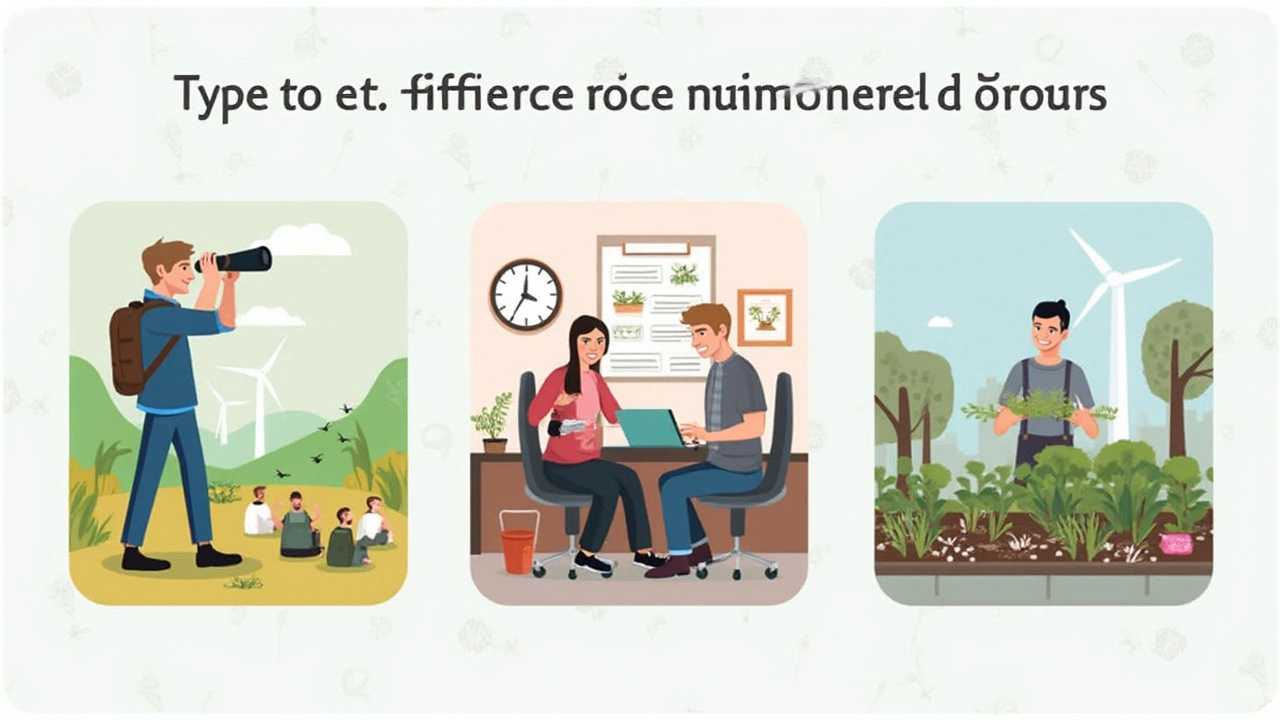How Many Groups of Environment Do We Have? Exploring Main Environmental Groups
 May, 10 2025
May, 10 2025
Ever looked at all those environmental groups and felt a bit lost about who does what? You’re not alone. It can get confusing fast because these groups work in so many ways—some plant trees, some fight for policy changes, and others collect data to prove a point. But they all have one goal: protect the planet, usually by focusing on a specific group or strategy.
Here’s a useful tip: environmental groups usually fall into a few major types, each with its own vibe and approach. Some are all about saving wildlife and forests. Others take on big companies. There are even groups that focus solely on teaching folks about climate and recycling. Once you know the main groups, it gets way easier to see where your passion fits in—or where your donation will actually make an impact.
- The Main Groups: Who’s Who in Environmental Work
- Conservationists: Protecting the Past and Future
- Activists and Advocates: Raising Voices for Change
- Researchers and Educators: Spreading Facts and Solutions
- How You Can Support the Group That Fits You
The Main Groups: Who’s Who in Environmental Work
If you’re trying to wrap your head around the different kinds of environmental groups, don’t worry—it’s not as complicated as it sounds. Most groups can be sorted into four main categories. Each one has its own focus, and they actually work together more often than you’d think.
Here’s a quick rundown of the most common types you’ll bump into:
- Conservation groups: These are the folks on a mission to protect nature, animals, forests, parks, and oceans. Think about names like The Nature Conservancy or WWF—they buy land, restore habitats, and safeguard endangered species.
- Advocacy and activist groups: Ever seen people holding banners or calling for new laws? That’s these groups. Greenpeace and Friends of the Earth are big examples, organizing protests and campaigns to push for government action or policy changes.
- Research and education organizations: These guys dive into data. They research climate change, pollution, and biodiversity—and then put out the facts, often teaching schools and communities too. The Environmental Defense Fund’s scientists or local nature centers fall in this camp.
- Grassroots and community groups: Sometimes, the biggest impact starts small. These local groups might clean up rivers, plant trees, or fight for cleaner air in their neighborhood. They usually run on volunteers and have a real “get your hands dirty” vibe.
Some groups mix more than one role, but they usually lean heavy into one core mission. Eager to see the differences? Check out these numbers:
| Group Type | Main Activity | Famous Examples | Estimated Global Share (%) |
|---|---|---|---|
| Conservation | Protecting nature & wildlife | The Nature Conservancy, WWF | 40% |
| Advocacy/Activism | Lobbying & Awareness | Greenpeace, Friends of the Earth | 25% |
| Research/Education | Science & Awareness | Environmental Defense Fund | 20% |
| Grassroots | Community work | 350.org, Local initiatives | 15% |
Each group has its own way of making change. Some shout, some plant trees, some crunch numbers. They all add up to a much bigger effort—no one type is more important than the rest. Want to join in? Pick the style that matches your own strengths or interests.
Conservationists: Protecting the Past and Future
When people talk about environmental groups, conservationists are usually what first comes to mind. These are the folks out there fighting to save forests, wetlands, rivers, and wildlife habitat. Their main goal? Hang on to our planet’s natural treasures—not just for us, but for future generations too.
The most familiar names in this space are organizations like the World Wildlife Fund (WWF), The Nature Conservancy, and Conservation International. These groups don’t just talk; they throw major effort into buying up land, restoring habitats, and keeping endangered animals out of the danger zone. For example, WWF played a big part in the comeback of the giant panda by helping set up protected areas in China, while The Nature Conservancy has saved over 125 million acres of land across the world since 1951.
Conservationist groups usually focus on one (or all) of these things:
- Protecting and managing nature reserves and parks
- Saving endangered species through direct programs like breeding and release
- Restoring damaged habitats—think replanting trees or cleaning up rivers
- Working with local communities so humans and nature can get along
And it’s not just about animals or plants. A lot of these groups are thinking long-term, too, fighting for clean water, clean air, and land you can actually walk on without stepping in trash. They use everything from old-school boots-on-the-ground work to high-tech tools like satellite tracking to spot illegal logging or poaching.
If you’re into action and results instead of endless debates, getting behind a environmental group with a conservation focus is a solid move. You could volunteer for trail clean-ups, jump in on a citizen science project to track animal sightings, or just donate directly to land-buying funds. Every bit counts—conservation is where small actions can actually protect big areas for decades to come.

Activists and Advocates: Raising Voices for Change
If you’ve ever seen a march for climate action or heard about a petition to stop pollution, you’ve seen activists and advocates in action. These folks are the loudspeakers of the environmental world. Their main job is to make issues public so change actually happens, whether that means organizing protests, writing to politicians, or rallying support online.
What sets these environmental groups apart? Instead of just talking or studying, they push real-world changes. Think of groups like Greenpeace or Extinction Rebellion—two well-known examples that use bold moves and creative protests to grab attention. These groups might chain themselves to trees, hold up traffic, or launch viral social media campaigns, depending on the impact they want.
And it’s not just about big drama. Countless local advocacy groups work quietly but steadily, pushing their towns and cities to adopt better recycling, protect green areas, or pass eco-friendly laws. A lot of change starts small, with regular people raising their voices about something that bugs them—like litter in a park or factory runoff in a local river.
Check out how much influence these groups can have with some solid stats:
| Group | Major Win | People Involved |
|---|---|---|
| Greenpeace | Helped ban commercial whaling in many countries | Over 3 million members worldwide |
| Extinction Rebellion | Pushed over 200 global cities to declare climate emergencies | Estimated 1 million+ in active protests since 2018 |
| The Sierra Club | Helped shut down more than 300 coal plants in the US | More than 800,000 members in the US |
Want to back these movers and shakers? Here’s what anyone can do to help advocates and activists:
- Sign and share petitions from trusted organizations—this really does build pressure on leaders.
- Join a local protest or rally, even if it’s just once. Your body counts, literally.
- Spread the word on social media about issues you care about and tag your local reps.
- Write a short letter or email to a politician—many say this gets noticed way more than people expect.
You don’t need to be loud or radical. Sometimes, just supporting the message or showing up is enough to make a legit difference.
Researchers and Educators: Spreading Facts and Solutions
Ever wonder who’s behind those chilling climate stats or the handy recycling guides you see everywhere? Meet the researchers and educators. These folks gather facts, crunch numbers, and find real-world fixes for all kinds of environmental headaches. They explain things in ways regular people can actually understand—plus, they hold businesses and governments accountable with cold hard data.
Take NASA’s climate team, for example. They track CO2 levels and global temperatures, sharing updates so everyone knows what’s up. Think tanks like the World Resources Institute dig into everything from clean energy policies to food waste numbers. Meanwhile, educators—like local eco-clubs and national science teachers’ associations—bring all this info into classrooms and community workshops.
Check out these quick facts about their impact:
| Group | Main Focus | Key Impact |
|---|---|---|
| NASA Climate | Tracking global atmospheric changes | Publishes real-time climate data, guiding global policy |
| World Resources Institute | Research & analysis on sustainability | Helped over 50 countries build climate strategies |
| Eco-Schools | Environmental education in schools | More than 59,000 schools in 68 countries teach eco-friendly habits |
Want to get the most out of what these environmental groups offer? Here’s what you can do:
- Follow their reports. NASA, for example, shares updates on greenhouse gas trends and sea level rise every month—just check their website or social media.
- Join local workshops or webinars. Groups like the Sierra Club or your city’s environmental council often host talks about recycling, energy-saving, and wildlife protection.
- Share proven info. Misinformation spreads fast, but sharing fact-checked resources from legit research groups makes a difference.
- Encourage your kid’s school to partner with organizations like Eco-Schools. Many offer free toolkits for teachers.
These researchers and educators are the backbone of smart environmental action. They make sure what we do is actually helping—and, honestly, the more people listen to them, the more likely we are to see real change on the ground.

How You Can Support the Group That Fits You
Think you need a science degree or a fat wallet to help the planet? Not true. Anyone can support environmental groups—it just takes knowing your options and matching them up with what you care about and what you can do.
Here are some real ways people like you make a difference every day:
- Volunteer work: Many local groups rely on volunteers for activities like planting trees, helping with cleanups, or collecting recycling. For example, the Ocean Conservancy’s International Coastal Cleanup saw over 17 million pounds of trash collected just last year, thanks to volunteers.
- Joining campaigns: Add your name to petitions, share on social media, or even show up for peaceful protests. Greenpeace and Friends of the Earth often organize digital campaigns where you only need a minute to speak up for change.
- Financial support: Even a small monthly donation can keep a research project running or help buy seedlings for a community garden. Places like The Nature Conservancy make it easy to give once or set up something ongoing.
- Learn & educate: Environmental education groups often look for people willing to lead workshops, post info in schools, or even just share trusted articles online.
- Change your lifestyle: Tiny changes count. Buy less single-use plastic, use public transport, or choose brands with real eco credentials. Groups like WWF break down exact ways to track your carbon footprint for free.
Here’s a quick snapshot of how support really adds up, using numbers from well-known organizations:
| Type of Support | What One Person Can Do | Real-world Results (2024) |
|---|---|---|
| Beach Cleanup Volunteer | Collect litter for 2 hours | Avg. 20 lbs trash removed per person (Ocean Conservancy) |
| Petition Signer | Sign & share climate petition | Over 4 million signatures led to key climate talks at COP28 |
| Monthly Donor | $10/month | Plants 50 trees/year (One Tree Planted) |
| Online Educator | Run 1 webinar | Boosts local recycling rates by up to 12% (EPA study) |
There’s no right or wrong way to help. The sweet spot is picking a group whose mission fires you up and then finding the kind of support that feels doable. Even a little action goes further than you might think—especially if you rope in friends or family!
